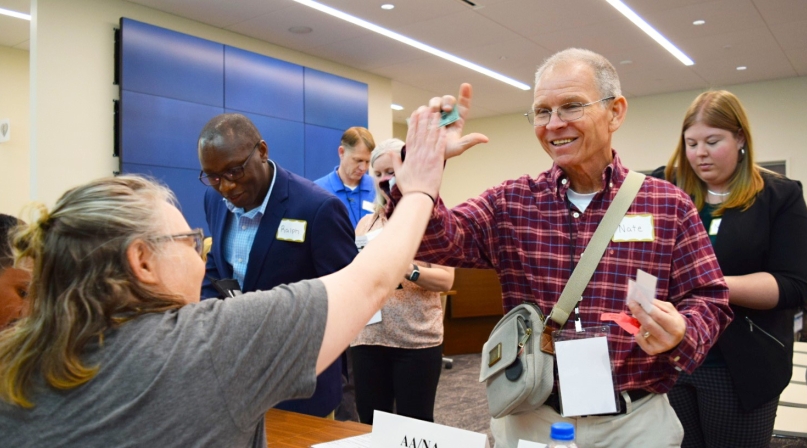Data analysis leads to better treatment for frequent users of social services

Key Takeaways
Haggling went nowhere. Excuses didn’t work. Pleading was useless.
When a man, recently released from incarceration, tried to get to his substance abuse counseling appointment, a missing bus ticket was becoming an insurmountable problem.
“I’m sorry, I can’t help you.”
He doesn’t have any money for a new bus ticket.
“I’m sorry, I can’t help you.”
He just got out of jail.
“I’m sorry, I can’t help you.”
If he doesn’t complete his counseling, he’s probably going back.
“I’m sorry, I can’t help you.”
The desperate man was a county official, visiting Johnson and Douglas counties in Kansas for the second Familiar Faces Leadership Network peer exchange April 11-13. His foil was a volunteer from Johnson County’s substance abuse treatment program, relishing the opportunity to turn the tables and show those in power what it’s like to have none while they acted out a Federal Bureau of Prisons reentry simulation.
Learn more
His experience mirrored many of the residents they were trying to help, those who are in the seemingly never-ending cycle of arrest and release. Mental illness or substance use disorder only make navigating those systems tougher.
“Some of y’all don’t realize you’re not in control anymore,” the volunteer said, loosening her grip on the role. “You don’t like not being in control.”
The exercise demonstrated how hard it is for residents leaving the justice system to stabilize their lives on the outside, and the seeming inevitability of running afoul of some rules, even if they aren’t reoffending. Then, perhaps, they could see their way out, where each of their counties could throw down a rope ladder, or with any luck, build a stairway out.
Systemic approaches
Chances are, many counties have the raw materials to assemble systems to better coordinate service delivery to residents in need, but the trick is putting them all together — the Familiar Faces Initiative’s ideal. Johnson County’s system, My Resource Connection, started coming together in 2008, after years of just missing connections.
“We did a lot of really great things, but we did them in a vacuum,” said Chris Schneweis, a senior business analyst in the county’s department of corrections. “We did it in siloed departments that didn't communicate when they were working with a similar individual. If I’m a probation officer, I focused on you and I worried about what the court says you need to do and that’s all I cared about. You don’t have food on the table? You can’t pay your rent? Not my problem, OK? We’d kick you down the road to somebody else.”
Schneweis and his colleagues across departments delivered those services in an uncoordinated manner, wasting money and at best helped clients tread water, but rarely helped them move forward with their lives.
My Resource Connection — MyRC — consolidates service delivery information, joining case managers who had been blindly working piecemeal with the same client and allowing access on a need-to-know basis, with heavy vetting by departments and extensive training before anyone can access private data. Rarely can anyone see an entire client’s file in detail.
“You get access to MyRC based on the department you work in, which determines what level of access you see,” Schneweis said. “Just because you have access and you’re a user of MyRC, that does not mean you get to see every piece of data from the application.”
The resulting system offers a no-wrong-doors approach in which every service provider has the agency to connect users with the greater resource offerings.
“Where we have made great strides is in the ability to notify others and say, ‘Look, you have this client and they just used the ambulance service last night,’” Schneweis said. “’Here’s the first impression,’ and that allows that case manager to then reach out to paramedics, have their client sign a release to get the additional information, maybe reach out like in this case, they couldn’t reach out to the hospital, because the client refused transport, so the best they can do is get with our ambulance service to find out ‘OK, what information is taken? What was the overall situation surrounding this individual?’
“If this client needs resources, by putting the check mark in the box, I now hit that service tab. I now jump over to the services section. I may be a probation officer, but you need rent assistance, so I could start typing in here ‘rent assistance...’ The application’s going to auto-populate what it thinks I’m looking for.”
Douglas County also uses MyRC, and Bob Tryanski, director of behavioral health projects, has seen how the system puts human service delivery numbers in perspective.
“In Douglas County, we have 122,000 people, but 122 people a year create 800 visits for the emergency department, so there’s a lot of opportunity if we could figure out who those 122 people are,” he said.
Douglas County’s MyRC algorithm assigns different weights to various interventions, including ambulance rides, emergency room visits and criminal justice interactions.
“The emergency room and ambulance rides are then weighted differently based on if they were behavioral health or non-behavioral health-related,” said Johnson County Epidemiology Director Elizabeth Holzschuh.
Megan Sparks, a Johnson County epidemiologist, said that while MyRC’s interface is refined, it shouldn’t intimidate counties.
“Many of you will likely have some level of data infrastructure,” she said. “It may not look like MyRC, but you likely already have something there, even if you don’t realize it yet, so don’t write it off completely.”
Holzschuh agreed, noting how easy it is to be “data rich” but “information poor.”
“Every one of your departments has a wealth of data, but what are we doing with it?” she said. “How are we turning that into actual information that can then be moved into action? That can improve the lives of your community members, allow them to live their healthiest life, which also subsequently means reducing the burden generally on county or community services?”
Better coordination
Better data offers the opportunity for more coherent strategies in service delivery.
Amanda Schwegler, a Johnson County mobile crisis response team leader, describes her department’s philosophy as “assertive outreach.”
“Our outreach efforts rise to meet the risk that we’re seeing in the folks that we’re interacting with,” she said, referring to vulnerable populations with very complex needs. “If they don’t have natural supports — friends, family and the community to help them do that — we become that support for them.”
Rob MacDougall, Johnson County’s director of emergency services, recognized that operational efficiencies were necessary for lasting change. When Johnson County added a basic health screening process, he knew the crisis line operators didn’t have the capacity to take on that added responsibility, so he created a referral system to the county’s non-business-hour crisis line.
Determining the antecedents to a county’s mental health crisis can help direct preventive efforts.
“If you invest money now in the idea of going upstream, of identifying those factors and policies that can actually impact the population, then maybe we can stem the tide of who ends up in crisis in the first place,” Holzschuh said.
Surrounding all of this information-sharing is the specter of the Health Insurance Portability and Accountability Act — HIPAA — which represents both a safeguard for patient information privacy and a misunderstood boogeyman.
“Some of what we had to overcome wasn’t just legal hurdles, wasn’t just HIPAA, it was also overcoming cultural experience,” Schneweis said.
“If you’re [working in] a state where it’s against state law to share that an individual’s on probation, HIPAA is the least of your worries then, because in most jurisdictions, court records are public.”
Holzschuh suggested involving HIPAA compliance officers early in the process of building data interfaces to avoid facing problems later.
Carnegie Mellon University professor Rayid Ghani, whose Data Science for the Public Good project has been working with Douglas and Johnson counties for five years, said he was motivated by the project’s potential to stave off future problems. By comparison, he said, other public health programs like tracking lead in drinking water, means charting damage that has already been done in a population. With MyRC, he said, data analysis can be done to help anticipate who needs active outreach from the county, which will assist the county in reaching the people who wouldn’t otherwise request services. He evoked an application of the data science’s program in Cook County, Ill. with HIV-positive patients.
“We’d get a list of people who haven’t picked up their prescription in over a year and then they would try to scramble to get them connected again,” he said. “They’d try to call them, go to their house. “They’re asking us, while we have them connected, give us this early warning that this person might not come back, so we can then start working on building a relationship with them,” because they’re more likely to disconnect and not come back.
MacDougall warns that even a sophisticated data system is not a cure-all.
“As useful as the tool is, I think you need to keep in mind that it is not going to capture everybody,” he said. “When we started getting arrest alerts for open clients, about 25 percent of those individuals that are in the open client system we’ve already assessed and diagnosed as severe mental illness that were not flagged by a brief mental health screen, so the awesome thing is we had both to give us that information.”
Allocation and attention
Scarce resources, even in a county that prioritizes human services in its budget, mean it’s unlikely everyone will get everything they need, so an important debate revolves around how they are best allocated.
Efficiency, Ghani said, can either mean dedicating your resources to people who are the cheapest to help, serving the largest number of people or making the most dramatic difference for the people suffering from the greatest inequities, which will narrow the scope of service.
“One of the things that we struggle with in these types of development systems, we kind of need to decide what we want this system to achieve,” he said. “Those are all uncomfortable conversations.”
Regardless of how a county allocates its resources to help people suffering from mental illness and justice system involvement, quality control is crucial. Though counties often find themselves as the convener, strategist and funder in justice initiatives, Douglas County’s Tryanski said another perspective that is valuable is making sure that systems work as designed.
“There’s another expert you need at the table, and that’s the lived-experience expert,” he said. “You need experts who have been failed by the system, because they know what it feels like and they know why it fails, but it’s hard for them sometimes to find the courage to speak up, because when you speak up, you get uninvited to meetings sometimes.”
As peer exchange participants found out, if you don’t hear from them while the work is in progress, you’ll probably hear from them after systems are in place.
Attachments
Related News

County Countdown – Dec. 15, 2025
Every other week, NACo's County Countdown reviews top federal policy advocacy items with an eye towards counties and the intergovernmental partnership.
Stretching small opioid settlement allocations helps funding do more
States and localities are set to receive $56 billion in opioid settlement dollars over an 18-year period, but not every county that receives settlement funding will get enough to build out infrastructure.

